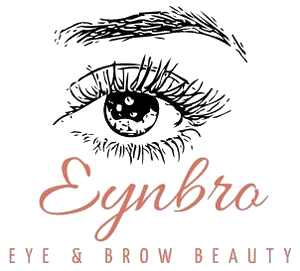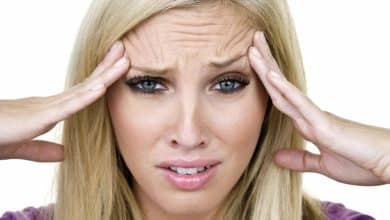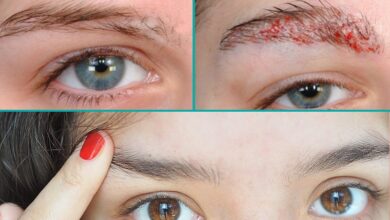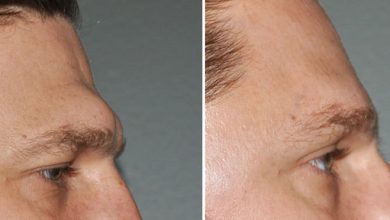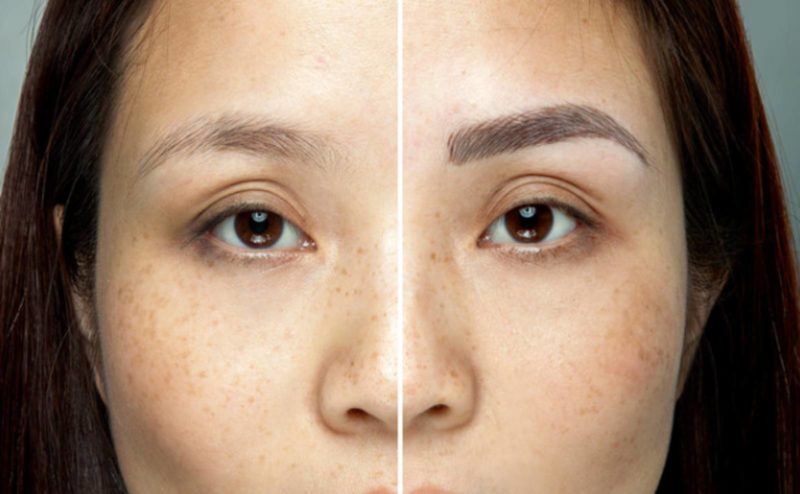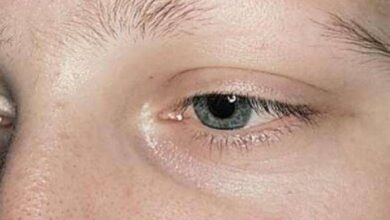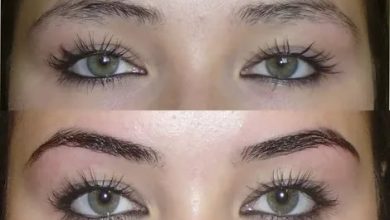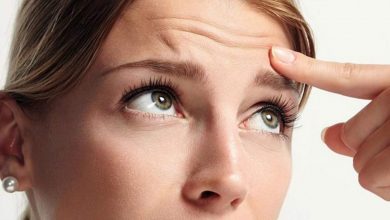My eyebrows are still itchy after 3 months Is this normal?

Cosmetic treatments such as waxing, threading and plucking can irritate the delicate skin around your eyebrows. Usually, the bumps and itching are mild and disappear within a few days. If symptoms persist, you may have a superficial skin infection.
Your doctor can help you determine if your eyebrow area is infected and tell you the best course of treatment. In some cases, a mild infection in this area can be safely treated with over-the-counter (OTC) products.
If your discomfort persists, consider making an appointment with your doctor. Your visit will likely include a physical exam and a conversation about your symptoms. If you have been keeping track of your symptoms, bring any notes to your doctor that may be helpful.
How do you stop your eyebrows from itching?
If the culprit is contact dermatitis, avoiding the product causing the irritation should help resolve it. In the meantime, moisturizing the skin around the eyebrows can help reduce irritation and flaking. Using an anti-itch cream or taking an antihistamine such as Benadryl can help reduce itching, and applying cool, wet compresses for 15 to 30 minutes at a time can help relieve the irritation and itching.
What is eyebrow dandruff?
Dandruff of the eyebrows is a similar problem to dandruff of the scalp. It results in the loss of flaky skin from the affected area.
Dandruff of the eyebrows can have several different causes. It can be dry skin, seborrheic dermatitis or contact dermatitis.
Does eyebrow dandruff go away?
Dandruff – as well as the skin conditions that cause eyebrow dandruff – are chronic conditions. Treatment can help alleviate the symptoms, but it will not cure the condition.
Dandruff of the eyebrows has periods of flare-ups and remission (absence of symptoms). Flare-ups occur most often during the winter months or when a person is under stress.
If you have tried home treatment and your symptoms do not go away or get worse, see your doctor.
Are eyebrow mites bad?
The Demodex folliculorum mite is a type of parasite that lives on humans. Most of the time, these mites are harmless and go unnoticed. However, large numbers of D. folliculorum mites can cause unwanted symptoms and skin problems.
D. folliculorum mites live in or around hair follicles, feeding on the dead cells, oils and hormones that accumulate there. These mites usually live on the face, including the eyelids and eyelashes.
D. folliculorum mites are more common in men than in women, with those in their 20s and 30s being the most likely to be affected.
In this article, we review the causes of D. folliculorum mites and the conditions associated with their presence. We also discuss diagnosis and treatment, including home remedies.
What makes your eyebrows itch?
Contact dermatitis is a form of eczema that develops when the skin comes into contact with an irritant.
It is a form of allergic reaction that can cause inflammation and dry, scaly skin immediately or several hours after contact with the irritant. Common irritants are perfumes and metals.
Contact dermatitis can cause itching and scaling of the eyebrows if the skin around the eyebrows has come into contact with:
- shampoo or shower gel
- specific cosmetic products
- an eyebrow piercing or other jewelry
How do you treat eyebrow dandruff?
Try using an anti-dandruff shampoo on the skin and hair of your eyebrows, taking care to avoid your eyes. Simply squeeze your shampoo into your hand, lather it up and apply it to your eyebrows, leaving it on for a few minutes before rinsing. Be careful not to over-wash your face, eyebrows and scalp, though, as this can strip your skin of necessary oils, drying it out even more and causing more flaking. You can also try using anti-itching and moisturizing creams on the skin under your eyebrows. Since this is a small area, you only need to use a small amount of lotion to be effective. We recommend two amazing, natural ingredients: tea tree oil and aloe vera. Several studies have shown that products containing tea tree oil can reduce dandruff with regular use. Warning: do not use pure tea tree oil directly on the skin! Look for products that contain tea tree oil. Or, if you have pure oil, be sure to dilute it with a “carrier oil” (i.e. another oil that has tea tree oil in it). Healthline recommends diluting 1-2 drops of tea tree oil with at least 12 drops of a carrier oil (olive oil, almond oil, coconut oil, etc). Aloe vera is another natural ingredient that can reduce dandruff and provide moisture and nutrients to the skin. If nothing helps, we recommend that you consult a dermatologist. He or she can help you identify the root cause of your eyebrow dandruff and possibly prescribe a medicated lotion or shampoo that can help.
How do you know if you have eyebrow mites?
The presence of a small amount of Demodex mites seems harmless, but a proliferation of mites – called “demodicosis” – can cause a multitude of symptoms affecting the eyes and other areas of the face. A Demodex infestation can also exacerbate pre-existing skin conditions like rosacea and acne.
Too much Demodex mite infestation can cause uncomfortable symptoms, such as:
- Itchy or burning eyes, especially in the morning
- Swollen eyelids
- Crusty eyes
- Red and irritated eyes
- Watery eyes
- Blurred or reduced vision
- Falling eyelashes
- Infected eyes
If you notice a yellowish discharge from your eyelashes, especially in the morning, it may be a sign of Demodex mite infestation.
Severe cases of demodex can lead to blepharitis – an inflammation of the eyelids. Blepharitis often leads to inflammation of the cornea called keratitis, a serious condition that can lead to blindness if not treated.
Why my eyebrow is itchy?
Itchy eyebrows can be embarrassing, but they usually go away on their own.
Itchy eyebrows can also be a sign of a skin condition, infection or allergic reaction.
Itchy eyebrows are relatively easy to treat, either with the help of a doctor or at home. Itchy eyebrows are not usually a cause for concern.
How do I take care of my eyebrows?
Brush your eyebrows daily as this stimulates hair growth and gives them a neat look.
Don’t over pluck. Ask your esthetician to remove unwanted hair, but keep it thick, because natural brows look better.
Try an eyebrow trimmer and remove only the hairs that have grown out of the line. This way, you can maintain the shape you like even if you can’t make it to the salon.
Massage your eyebrows with castor oil and then comb them out. Do this every night because castor oil makes your hair grow thicker.
Apply aloe vera gel to your eyebrows. It can help soothe any irritation after shaping them and even promote shine.
Don’t forget to exfoliate your brows, as impurities can also get trapped in them and cause acne or other skin problems. Mix a teaspoon of olive oil with a teaspoon of sugar, scrub and rinse. Do this in the shower at least twice a week.
Use an eyebrow growth serum instead of a regular eyebrow gel when you go out.
Why are my eyebrows itchy after Microblading?
Sometimes after microblading, clients develop dry, scaly skin. It is very important not to rub, pick or peel the scales or crusts. Itching is absolutely normal as the skin repairs itself. Never rub the treated area as this will disrupt the natural healing process of the skin. If your forehead is wet at the beginning of the healing process, simply dry it with a lint-free cloth. How you care for your new brow after microblading will have a significant impact on its appearance. Improper care often results in discoloration or a “patchy” brow.
Note that due to the natural regeneration of the skin, eyebrows may appear lighter than they originally did after the recovery period. Often, even with proper care, clients develop bald spots or lose the original hair, resulting in uneven looking brows. This is normal because the natural regeneration of your skin is not a process that the technician can control. This is why most clients need a touch-up after a month to ensure that the brows are perfectly even and that the desired effect has been achieved.
